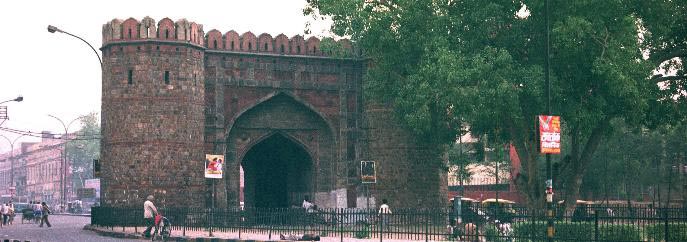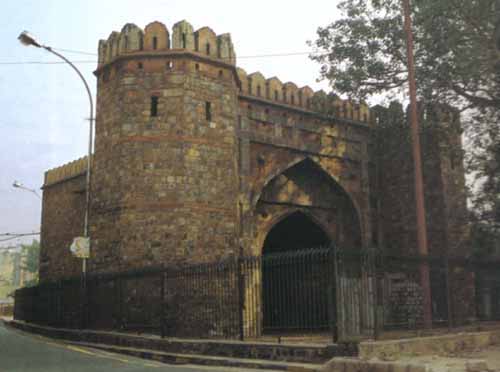 |

|
 |

|

|
|
Alai Darwaza, Delhi Gate
Talaq-I-Darwaza Khooni Darwaza Kashmiri Gate
Khuni Darwaza Kashmiri Gate Gates of Delhi Delhi was described as the city of "seven castles an fifty two gates' by a European merchant, Finch in 1611 AD. Today, only 13 gates exist and can be identified. A few of them are in ruins while many are in fair conditions of preservation. Lal Kot was built by the Tomar ruler Anangpal I in about 731 A.D and rebuilt by Anangpal II in 11th century when he transferred the Capital from Kannauj to Delhi. The Chauhans defeated the Tomars in 12th century AD. Prithviraj extended the old city of Lal Kot and added ramparts and moat. It came to be known as Qila-I-Rai Pithora, the first city of Delhi. Lal Kot was an oblong structure having seven gates-Sohna, Ranjit, Ghazni, Hauz Rani, Barka, Budaun and Maya. The traces of Hauz Rani, Barka and Buduan can still be seen around the remains of the Lal Kot in the present Mehrauli area. Alai Darwaza is the southern gateway to the extended Quwwatul Islam mosque and is described as one of the most treasured gems of Islamic architecture. It was built by Alauddin Khalji in 1311AD. It is the first building, which used true Islamic architectural principles of accurate construction and geometric ornamentation. The darwaza is a square, domed building with intricate carvings in red sandstone and marble. It is also the first building to have a horse shoe shaped arch and a dome. Talaq-I-Darwaza is the northern gate of Purana Qila. It was built around 1533-34 AD. It is one of the most exquisite gateways in Delhi and was aligned with the central vista by Sir Edwin Lutyens. It was made of random rubble with dressed stone facing. The gate consists of a lofty arch with two smaller arched openings within. The second floor of the gate has two openings. The gate is flanked by two circular bastions, which have high ceiling rooms. Humayun Darwaza is the southern gate of the Old Fort. It is called Humayun Gate probably because Humayun constructed it or the tomb of Humayun is visible from there. The entry into Old Fort is through the third gate called Bara Darwaza. The Khooni Darwaza was a building belonging to Sher Shah Suri's reign and situated opposite the Ferozeshah Kotla It was known as the Kabuli Darwaza because caravans to Afghanistan passed through this. The gateway is 15.5 m high and built of Delhi quartzite stone it has three staircases leading to different levels of the gate. The gate became popular as the Khooni Darwaza during the Moghul days. Though even in Sher Shah's time, it was used presumably both as an outpost and the place where heads of criminals were exhibited, since it was on the outskirts of the city. Emperor Jahangir, in the early decades of the 17th century AD, ordered the killing of the two sons of Abdur Rahim Khan-e-Khanan here on the charges of being the traitors. The bodies of the Khan-e-Khanan's sons were left here to be eaten by birds of prey. Aurangzeb hanged the head of his elder brother Dara Shikoh at the gate after he ousted his father Shahjahan. The Lal Darwaza was opposite the Old Fort or the Purana Qila. It is also called the Sher Shah Gate. It is a double-storeyed structure build of red sandstone and gray quartzite. On September 22, 1857 Major Hodson murdered the sons of Bahadur Shah Zafar, Mirza Mughal and Mirza Khizr Sultan and grandson Mirza Abu Bakar, at the gate after the king's surrender to the British. The princes were brought from Humayun's Tomb in Nizamuddin where Zafar had taken refuge in a bullock cart. The Khooni Darwaza saw bloodshed again during the riots of 1947. Many refugees were murdered here while they were proceeding towards Purana Qila for their safety. 
Tripolia Darwaza or the triple gateway was built during the later Mughal period by Nazir Mahaldar Khan in 1728-29 AD. The gateway was built of brick and layers of sandstone. It is unique in its design as no other gateway in Delhi has a triple passage. The only other gateway with more than one passage is the Kashmiri Gate. India Gate is located in Rajpath and was the first gate to be constructed in the New Delhi. It was built as a War Memorial to commemorate the death of 90,000 India soldiers, who were killed in the North West Province during the First World War and the Afghan Fiasco of 1919. The Duke of Connaught laid the foundation of this Memorial on 10th February 1921. The India Gate was designed by Sir Edwin Lutyens and was completed in 1931. The gate is built of sandstone rising to a height of 160 ft. the height of the arch is 136' externally and 87'6" internally. The names of the soldiers
are inscribed on the walls of the gate. An eternal flame called Amar Jawan
Jyoti is always burning to honor the soldiers who were killed in the 1971
war with Pakistan. A red sandstone canopy also designed by Lutyens stands
nearby, which once housed the statue of King George V. it has now been
removed from there.
|
 |